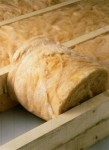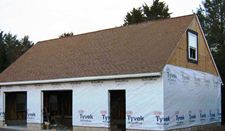For those of you long-time readers, I have finally managed to weave The Smashing Pumpkins into an article. Their hit single 1979 takes me back to my days at Lucas Plywood and Lumber, where I shared an office with Al Mercer.
Whilst I was gleefully entertained running the prefabricated roof truss plant (and selling a few pole building kit packages), Al was selling installed insulation. Thanks to him I did learn a few things.
 One of those was in relationship to smashing overthick fiberglass batts into wall cavities. The idea using 5-1/2 inch thick fiberglass batts in a 2×4 (3-1/2 inch thick) wall, the insulation will have a higher R-value than standard 3-1/2 inch batts provide.
One of those was in relationship to smashing overthick fiberglass batts into wall cavities. The idea using 5-1/2 inch thick fiberglass batts in a 2×4 (3-1/2 inch thick) wall, the insulation will have a higher R-value than standard 3-1/2 inch batts provide.
There is a degree (pun intended) of correctness in this. When you compress fiberglass insulation, you increase its R-value per inch, up to a point. However, when you compress a batt of a particular thickness, the total R-value does decrease. For example, standard low-density batts, at their nominal rated thickness — R-11 at 3 1/2 inches, or R-19 at 6 inches — have an R-value of about 3.1 per inch. If you compress a 6-inch R-19 batt into a 3 1/2-inch cavity, you get about R-14, or 4.0 per inch. This is a much higher R-value per inch, but the total value of R-14 is still substantially less than the R-19 you started with. Even in a 5 1/2-inch wall, the R-19 (which is rated at 6 inches of thickness) gives you only R-18.
For the best performance, any batt should be installed carefully, to fill the entire space without compressing around wires, pipes, bridging, or other obstructions. For those seeking higher R-values per inch than standard fiberglass batts, one alternative to compressing large batts into small cavities is to use so-called high-density batts (R-13 or R-15 at 3 1/2 inches, or R-21 at 5 1/2 inches). Although they cost more than standard batts, they are stiffer, easier to fluff up, and easier to cut around obstructions in wall framing. These factors result in a bigger benefit in real-world performance than the factory ratings indicate.
One of the wonderful things about pole (post frame) buildings, is the ability to economically create deep wall cavities which can then be insulated appropriately without crushing the fiberglass.









